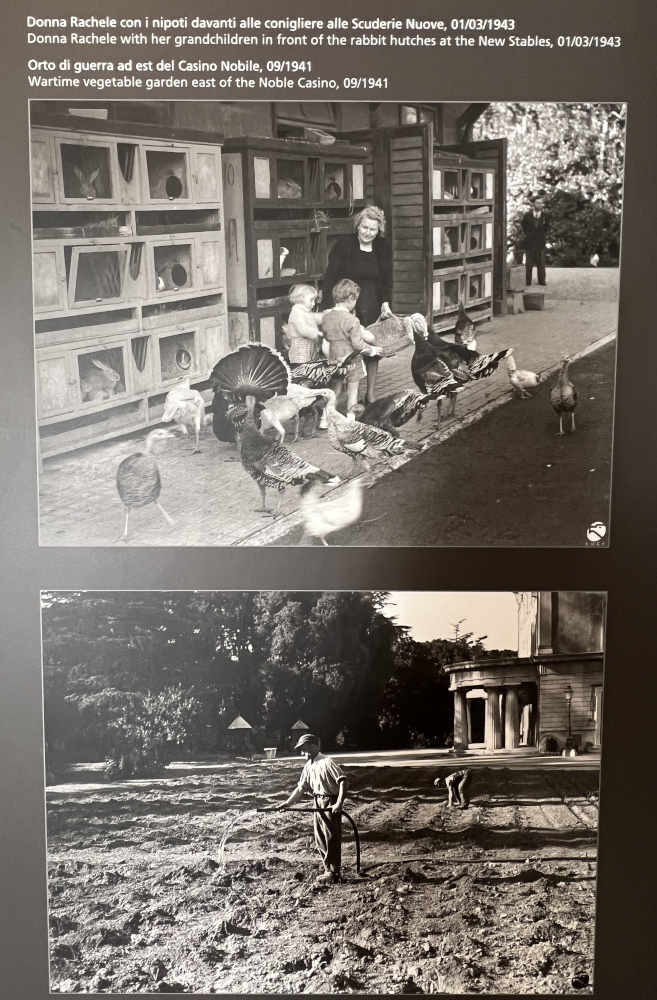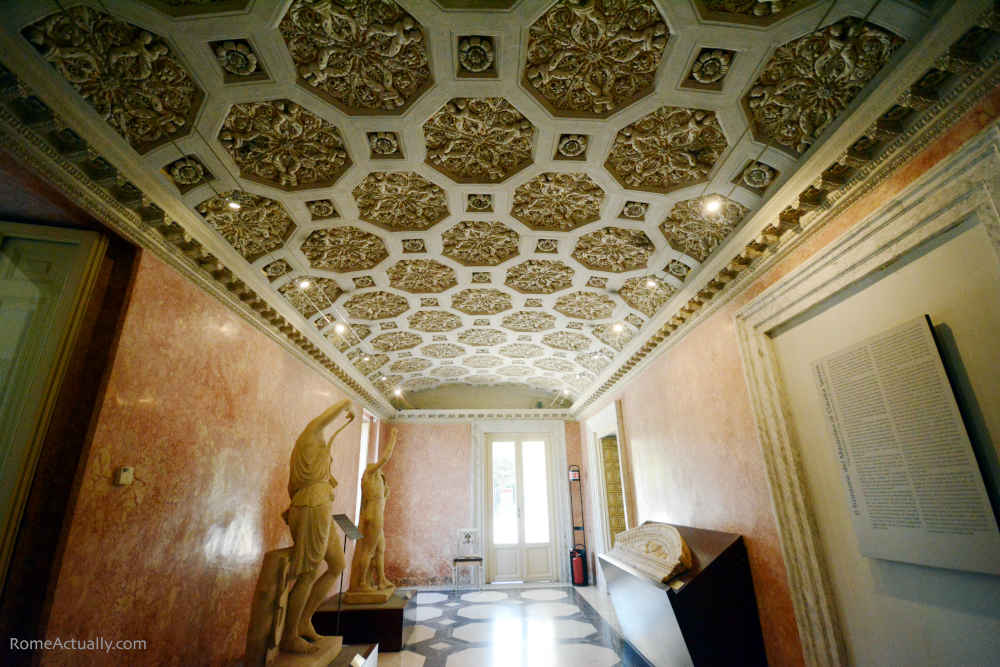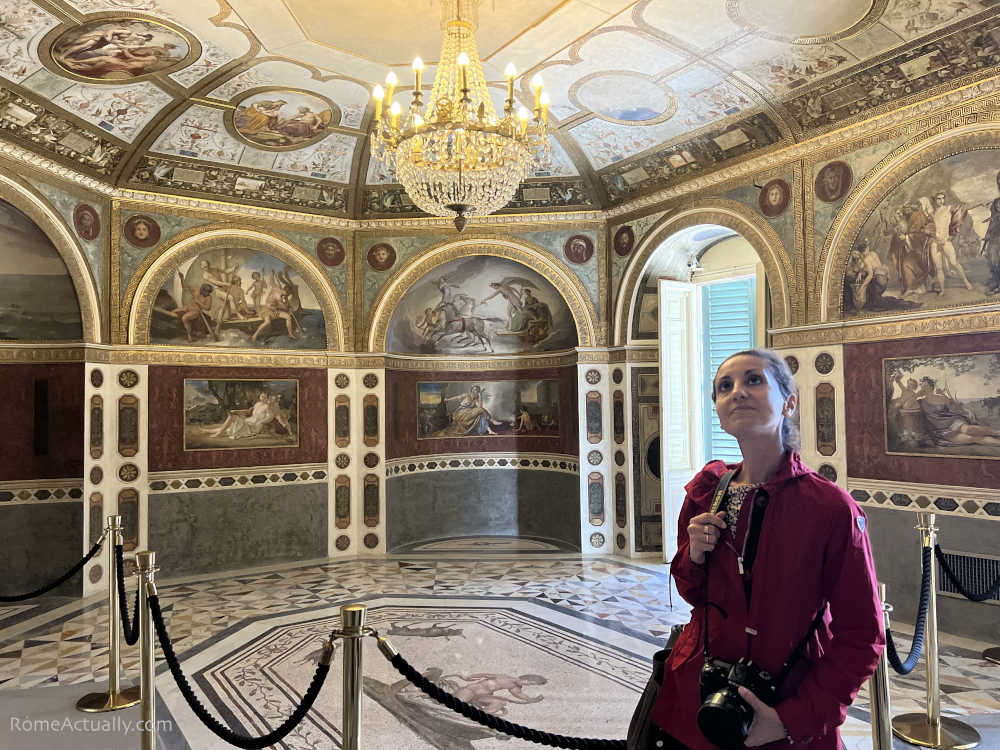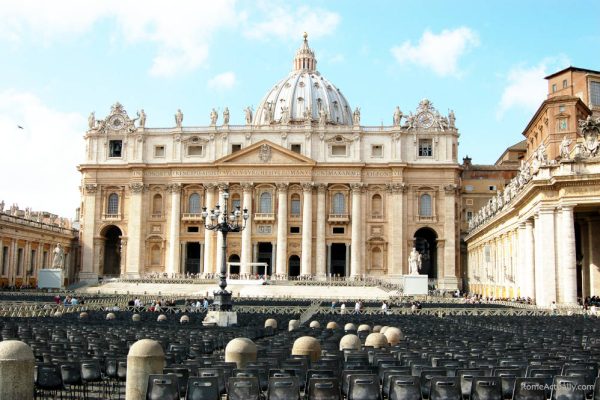Alongside the Owls’ Lodge (Casina delle Civette) and the Moorish-style Greenhouse (Serra Moresca), Casino Nobile is one of the buildings of Villa Torlonia park that are absolutely worth a visit. Serving as Mussolini’s house in Rome during the Fascist regime, Casino Nobile is a fascinating building revealing of Roman modern art and architecture.
Associated with one of the most controversial figures of Italian modern history, Benito Mussolini, Casino Nobile makes for an intriguing landmark to explore. It opens a great window on the private life of Italy’s Fascist Duce and his family, showing where and how they lived, and how their power came to an end.
Even though famous for being Mussolini’s Roman residence, Casino Nobile reveals quirky details of a little-known side of Rome and its history. An important piece of Italian contemporary art and the deeds of a wealthy family, the Torlonia clan, that tried its best to enter the realm of the Roman aristocracy.
Follow along while we explore every room of this beautiful palace and try to unveil the secrets of the families that inhabited it each in different moments of history.

History of Casino Nobile
In 1797, the rich banker Giovanni Torlonia bought a large vineyard along Via Nomentana from the Colonna family. The first thing that he did was to hire the famous architect Giuseppe Valadier to give a sumptuous and monumental look to its existing buildings.
The goal of Giovanni Torlonia was to make the vineyard a spectacular noble villa in Rome, able to compete with the other historical villas belonging to notable local families such as Villa Borghese and Villa Pamphilj.
Between 1802 and 1806, Valadier led the renovation and expansion works of Casino Nobile. This massive refurbishment included the addition of external elements such as porches and large terraces.
After Giovanni Torlonia died, his son Alessandro hired Giovan Battista Caretti to give Casino Nobile an even more majestic look and spruce it up with the aid of local artists.
Mussolini’s family in the Casino Nobile
The Italian Duce Benito Mussolini lived in the Casino Nobile with all his family between 1925 and 1943. All the original furniture was kept and all rooms were used. Mussolini was sleeping in the prince’s bedroom, his wife, Donna Rachele, in the bedroom on the other side of the building, while the second floor was devoted to his children and the domestic workers.
From the basement, the kitchens were moved to the attic and the upper floor and terrace were used for the laundry.
Mussolini’s office/study was near his bedroom, in the beautiful Egyptian Room while the living rooms and dining halls of the ground floor were used by the whole family for studying or to welcome guests.



Casino Nobile, however, was really the private residence of the Mussolini family and official visits and public parties were pretty rare. Even the beautiful ballroom was mainly used for private playing and entertaining purposes such as movie projections. One of the few and probably most famous events held in the ballroom was the official visit of Mahatma Gandhi in 1931.
Among the other rooms, Alexander’s Room was used as the dining hall, maintaining the habits of the Torlonia clan, while Bacchus’ Room was the living room, where the members of the Mussolini family gathered after the meals.
The public events of the Mussolini family mainly took place in the park with parties, fencing training, official meetings, and the wedding of his daughter Edda with Galeazzo Ciano in 1930.
During the war, Donna Rachele Mussolini promoted the creation of a vegetable garden in the park to give a good example to Italian families on how to face the hard times caused by the war. In the park in front of the Casino Nobile, they planted salad, potatoes, wheat, and grape. In the old stables (Scuderie Vecchie), they established a henhouse, a pig shed, and a rabbit cage.
Architecture and decoration
Originally, the central room, today’s ballroom, was known as “Salle à manger”, dining hall, and was kept very bright by a large semi-circular window and the walls entirely covered with mirrors to give the impression of a wider space.
In the exterior, to the original facade designed by Valadier, when Alessandro Torlonia took over the palace at the death of his father Giovanni, a Neo-classic, majestic pronaos was added and completed with an upper monumental lodge closed by a triangular fronton inside which is a beautiful high-relief by Rinaldo Rinaldi.
On both eastern and western sides of the building are two porticoes with Doric pillars.
The exterior of Casino Nobile might loo quite austere, but once inside, you are going to immerse in fine art, beautifully decorated rooms, eclectic artistic styles, paintings, sculptures, lavish rooms.

Rooms of Casino Nobile
The mausoleum of Claudia Semne
Your tour will start from a corridor displaying some of the vestiges from the mausoleum of Claudia Semne, a woman who died in the 2nd century and was buried in the Appian Way.
While it was forbidden to bury their own loved ones within the Roman walls in ancient times, on the outside, citizens could do what they wanted. In fact, along the Appian Way you can find several funerary mauseolums.
In ancient Greek, Semne is a word that was used to mean “sacred”, “revered”, a little like the term “augustus” in Rome. According to the vestiges of her mausoleum, Claudia Semne left behind a young son and a grieved husband who decided to commemorate his beloved wife with a beautiful shrine.
Found inside a vast land, likely an estate of the husband, Marcus Crotonensis Ulpio, probably a rich freedman, the mausoleum shows us Claudia Semne as Venus, Spes, and Fortuna through beautiful marble carvings, along with several inscriptions.
In the first corridor of Casino Nobile palace are kept the fronton of the mausoleum together with a few statues.

The bathroom
The first room you will find on your right after crossing the corridor is an elegant bathroom finely decorated with paintings, ancient pillars, and a sky-blue ceiling.
This sophisticated space was inspired by the similar toiletries and bathrooms of the 16th century. The walls and the vault are decorated with grotesques over a red background painted by Givan Battista Caretti.
The decorative panels with mythological tales with goddesses such as “Leda with the swan”, “The birth of Venus”, “Diana and Callixtus”, and Pan and Siringa”, are the work of Pietro Paoletti.
The room is divided by a row of ancient white alabaster pillars. The smaller, more intimate part hosted a bathtub, also made of alabaster.
When Annamaria, the daughter of Alessandro Torlonia, inherited the villa, the bathroom was turned into a chapel, and the walls were covered with wall fabric.

The ballroom
The largest and most visually impressive area of the Casino Nobile is the sumptuous ballroom, the central room of the palace around which are all the other spaces. From the original design by Giuseppe Valadier, Giovan Battista Caretti kept the overall structure but brought important changes to the simplicity and brightness of the room.
Adding rich decorative elements such as paintings, stuccos, gold plating, and marble over all the surfaces sacrificed the sense of space of a room that was already not very large. The further addition of two side orchestra pits supported by imposing pillars made with Carrara marble to host musicians during the parties and replacing the existing mirrors with frescoes made the room even darker.

The overall result, however, remains one of luxury and opulence in line with the desire for the ostentation of the owner, prince Alessandro Torlonia.
The ceiling of the ballroom is rich in frescoes by artists such as Domenico Toietti, Leonardo Massabò, and Francesco Coghetti, the author of the large Parnaso painting facing the window. Around the figure of Apollo, it’s possible to recognize notables such as Dante with Beatrice, scientists such as Galileo Galilei and Isaac Newton, and poets like Francesco Petrarca, Torquato Tasso, Ludovico Ariosto, and Homer.
The original polychrome mosaic decorating the floor has been replaced by wood flooring first and then by marble.


Italian artists and poets’ room
In this Gothic-style room painted by Giovan Battista Caretti you will see 32 plates with the portraits of famous figures painted by Pietro Paoletti. One of these is the portrait of Carlo Torlonia, the brother of Alessandro, replacing the one of Renaissance painter and architect Giorgio Vasari.
Along with the paintings, this room displays a cast-iron statue of Diana Gabina, the copy of the marble sculpture found in the ancient city of Gabii, today an archaeological site in Rome in Via Prenestina Nuova.
Don’t miss our article on the most impressive archaeological and ancient sites to visit in Rome!

Bedrooms
On the two corners of the palace are the two symmetrical bedrooms, one used by Benito Mussolini and one by his wife. In the room of the Duce we can see the original furniture as arranged by Giovanni Torlonia, former dweller.
Opening to the terrace and a view of the park, the vaulted ceiling of Mussolini’s bedroom is decorated with a round painting of Sleep carried away by his sons, the dreams, Il Sonno portato in volo dai Sogni (I figli Morfeo, Icelo e Fantaso).

Alexander’s Room
Together with Bacchus’ Room, Alexander’s is one of the most opulent spaces in Casino Nobile. As shown by the marble and carved wooden shelves disposed on the walls, it was used as a dining hall by the Mussolini family and the Torlonia clan before them.
The main and only theme of this room’s decorations turns around Alexander the Great and his deeds with a clear praise of Alessandro Torlonia, the patron who ordered the paintings.
All over the ceiling are beautiful paintings portraying different moments of Alexander the Great’s life and battles including his triumphant entrance in Babylon, the battle of Isso, and Alexander and the Pythis priestess.

Right underneath runs all around the bas-relief frieze “The Triumph of Alexander in Babylonia”, famous work by the Danish sculptor Bertel Thorvaldsen, the original of which in marble is kept in the Quirinale palace, one of the most impressive and famous buildings in Rome, and copied in several patrician mansions.
Marble statues of Apollo and the nine Muses are placed in the wall niches, while the angels and the allegoric figures on the walls evoke the virtues of Alexander from Macedonia.
Take some time to admire the beautiful floor decorated by Carlo Seni with Etruscan-style mosaics.

Bacchus’ Room
One of the most lavish and scenic rooms in the palace, Bacchus’ Hall was entirely frescoed by Francesco Podesti with stories of Bacchus and themes like the seasons and the Continents.
The floor features a beautiful polychrome mosaic with Hercules child choking the snakes and all around colourful marble inlay works and more smaller mosaics portraying the Labours of Hercules.
Unfortunately, part of the ceiling has collapsed and much of the original decorations went lost. Nevertheless, this is a stunning room.

Egyptian Room
This Egyptian-themed space is consistent with the eclectic style of the Casino Nobile palace as well as the other buildings of Villa Torlonia. As soon as you step inside this room, you will see everything evocative of the Egyptian culture, from the embodiment of the Nile to the sphinx to the pyramids.
Sophisticated hieroglyphic motifs are the common pattern over the marble floor and around paintings representing moments of Cleopatra’s life such as meeting Antony, the incarnation of Antony and Cleopatra, and Cleopatra kneeling in front of Antony.

Gothic Room
This room evokes a Gothic style all over its decoration such as the false glass along its walls and the patterns of its marble floor.
In the vaulted ceiling you will see an elaborate pattern inside which are the representations of two episodes of the Gerusalemme Liberata (Jerusalem Delivered) an epico poem by Torquato Tasso.
Museum of Scuola Romana
Since 2006, the upper floor of Casino Nobile has been hosting the Museum of the Scuola Romana, the group of painters in Rome that between the two world wars gathered to research the compromise between the modern post-Cubist language and the ancient art.
Some of the painters you will see exposed in the museum include Corrado Cagli, Giuseppe Capogrossi, and Emanuele Cavalli, the realists Renato Guttuso, Fausto Pirandello, and Alberto Ziveri, and those belonging to the movement known as “Scuola di Via Cavour” (School of Cavour st.) such as Mario Mafai and Antonietta Raphaël.

Mussolini’s bunker
The breaking out of the war required leveling up the security measures for Benito Mussolini and his family. Identifying a shelter where to hide in case of air raids at a time when Villa Torlonia was a target of shellings became an urgent matter.
A first refuge was realized in a cave located between the Theater and the manmade lake “Laghetto del Fucino” built by Alessandro Torlonia.
From the entrance, a long corridor was followed by a set of steps that led even more underground. This first shelter was equipped with steel doors, a gas filter, electricity, a toilet, a phone, a first-aid kit, and mattresses.
Soon, however, became clear that the distance between the shelter and Casino Nobile where the family was living was a problem. The fact that it was right under the lake made it an easy visual target.
Initially, they thought about filling the lake with dirt as a sort of camouflage, but soon a better alternative was found from inside Casino Nobile itself. They fortified the basement below the ballroom adding an extra layer of 120 cm of reinforced concrete to its ceiling and isolated it with two watertight iron doors. This new shelter featured also a decontamination room with showers and sinks to get rid of potential gas traces from the skin.
As the danger of heavy shelling approached, building a more modern bunker became a necessity. The new air-raid shelter was 6,50-meter deep out of the palace foundations but accessible from the basement. Cylindrical in shape to better resist the pressure caused by the bombs, the shelter was protected by a 4-meter-thick wall of reinforced concrete.
Cross-shaped the shelter consisted of several rooms and featured two security exits, both external to the Casino Nobile palace.
This latest bunker was never completed because Mussolini had to flee Villa Torlonia and then was arrested on July 25th, 1943, after the Badoglio government was put in charge. This was only a few days after the “Lucky Lady” warplane of the allies dropped its bombs on Rome. The bombing was particularly devastating in the San Lorenzo quarter not far from Villa Torlonia.
Even though unfinished, the bunker of Villa Torlonia was used by its dwellers and the residents of the nearby neighborhoods during the German occupation.
Mussolini’s bunker of Villa Torlonia has been restored and made easily accessible to visitors. During the renovation works, a 1st-century grave was found. This is also visible when visiting the bunker.
- Entrance fee for the bunker: €10.
- The tour lasts 1 hour.
- The tour runs in Italian, English, French, German, Spanish, Dutch, and Hebrew. The language must be requested at the time of booking.
Unfortunately, at the moment Villa Torlonia’s bunker is closed due to the end of the contract with the company that was running the tours. We are waiting for an update on new openings.
Plan your visit to Casino Nobile in Villa Torlonia Park
- Address: Via Nomentana 70.
- How to reach Casino Nobile: By metro (Sant’Agnese Annibaliano and Bologna stops, B line), by bus (62, 66, 82), by tram (2, 3, 19).
- Opening hours: Tuesday to Sunday 9 am-7 pm. Closed on Monday.
- Entrance fee: The ticket for Casino Nobile costs € 7.50, but if you want to visit more than one landmark, you can purchase a discounted collective ticket. These are the options: Casina delle Civette + Casino Nobile + Serra Moresca: €11.50; Casina delle Civette + Casino Nobile: €9.50.
- How to buy your ticket: The ticket offices of Villa Torlonia are in the Casino Nobile or the Serra Moresca (that opens at 10 am instead of 9), Casina delle Civette doesn’t a ticket office. In the high season, it’s recommended booking your ticket online from the official website or over the phone calling the number 060608. Pre-sale charge is 1€.
WANT TO READ IT LATER? PIN IT TO YOUR BOARD!





